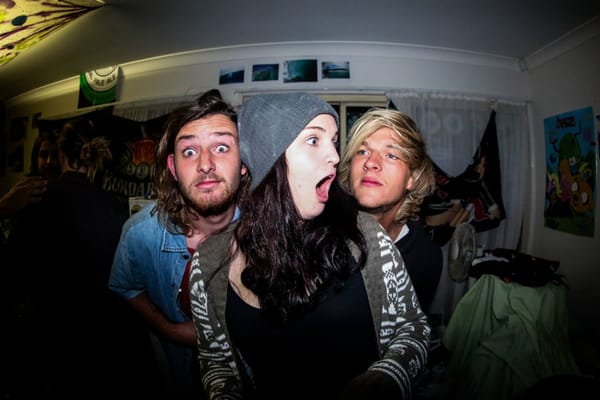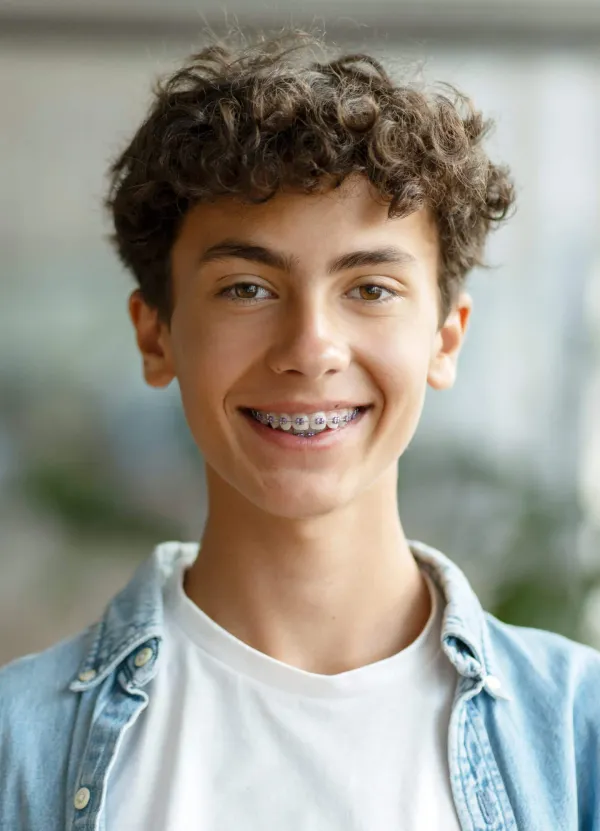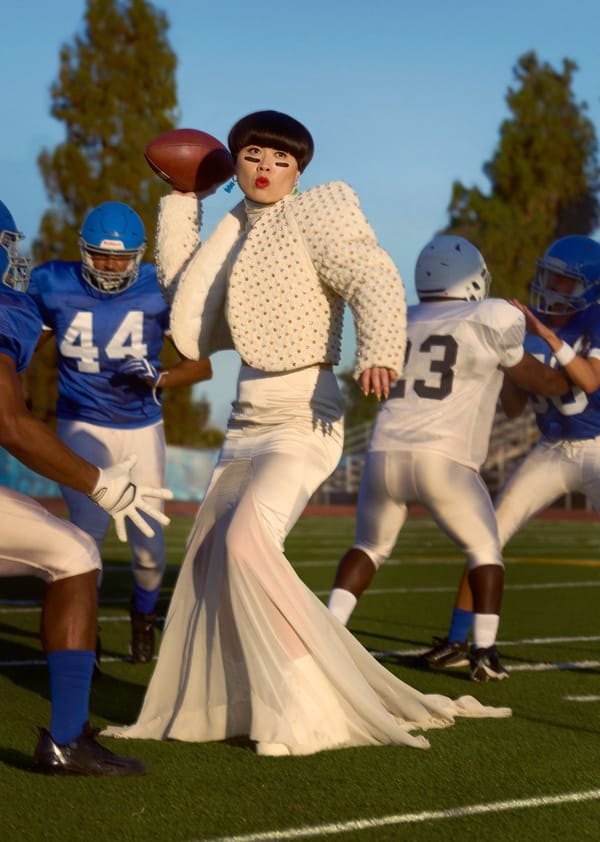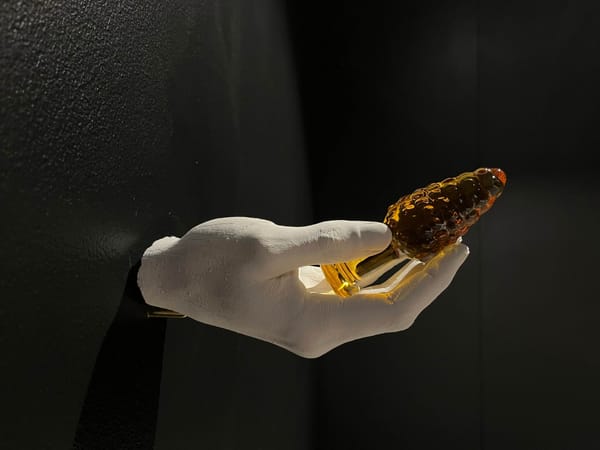What Wave of Feminism is this?
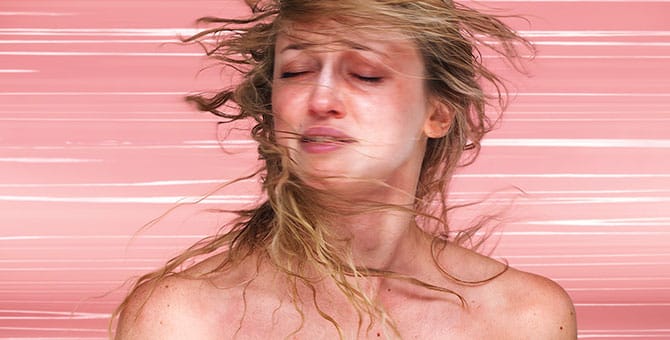
An exhibition review of sorts.
Confronting Femininity - Institute of Modern Art
4 October–21 December 2025
Curated by Sal Edwards, Robert Leonard
Artists: Michaela Stark, Natalya Hughes, Rosemary Laing
Positionality Statement: For brevities sake, you can skip this and go straight to the review if you like, there will be a 'start here' in all caps.
Earlier this week while driving to so called Brisbane, I was listening to The Messy Truth by Gem Fletcher. I'd burnt through a few episodes on this drive down from the Sunshine Coast and landed on one with Vince Aletti. For those who don't know Vince Aletti, is a writer, critic and curator from New York, who has been prolifically writing since 1970. As a critic Aletti, has been a major voice in the world of contemporary photography, reviewing photography exhibitions for the likes of The Village Voice and New Yorker right up until 2016. And while Aletti still writes actively, changes to the media, photography and arts has seen him move into curating and book making of late.
I share this because, as I mentioned in my last arts response, context and the personal is important information for audiences to engage with not only these words but of course, arts exhibitions. The first piece of context for those who don't know me, especially for this review, is that I'm a white person on a salaried income who passes as a straight cis-hetero male. That doesn't mean I am all of those things just that I benefit from the privilege of fitting into those boxes until I choose not too. I live and work on stolen lands around the so called Sunshine Coast and Brisbane, they unceded lands of the Kabi Kabi (Gubbi Gubbi) people, Jinibara people and lands of the Turrbal and Jagera people.
I walked up from James St having quickly checked if OUTERSPACE and IMA were open before setting up the slight hill in the midday October heat. It feels like Summer already. But as I walked up the hill, I was thinking about Aletti and his conversation with Fletcher. On how they thought about photography and its need to be exhibited. That its in the ephemeral space of an exhibition that photography comes to life. Off of screens and onto walls or into hands through prints and publications. Presentation, materiality, volume, positioning and scale all come together to try and convey what the photographer had sought to achieve. Finally air-conditioning at least anyway.
NOTE: I'll write about Joel Sherwood's exhibition "Spring: Diggermode 2: Cloud Ceding" which was programmed alongside Confronting Femininity, in a couple of days.
START HERE:
Moving through the space from Sherwood's exhibition, Confronting Femininity was immediately separated by the bright stark lighting in the gallery space. Taking notes in reverse and negating to read to deeply yet, I immediately struggled with Natalya Hughes's works in the first gallery space. The gallery featured five paintings of varying sizes, from roughly 3m X 2m's down to 50 x 60cm's in size. The works were all made in 2024 and were the most recently created works featured in the exhibition as a whole. While beautifully painted and immaculately detailed, they felt confused, completely abstracted and too subtle to fit the broader meaning of the exhibition. The works felt to be referencing elements of European Orientalism alongside traditional fashions from the French and English. All cartoonishly portrayed on a colour palette to match, featuring lilacs, soft oranges and light greens. I was almost waiting to see the head of Bugs Bunny or Daffy Duck pop out of the abstracted costumes and spring to life in some sort of caper. With all of this, the works almost didn't come across as feminine but masculine in their abstraction and absurdity.
Hughes's references were lost on me and I made a note to look them up later.
Before writing this, I look up Erté Romaine de Tirtoff works. And suddenly Hughes's works make sense and I can see where the colours come, the effeminate shapes and flow of the works. And where the sense of the absurd and explosions of life I sensed lay. While my reminders of Looney Tunes characters is all my own nostalgia, I can't help but wonder how much of an influence Erté was to artists behind Bugs. This is what Hughes has done so successfully in referencing and expanding upon Erté. Taking the imagery of garments manufactured and designed to be a controlling extension of idealised beauty by patriarchal controls and reclaiming them through the female lived experience.
I feel okay about thinking about Bugs and Daffy now. Maybe not Hughes's intention but it feels like an earnest and honest response, especially with my limited knowledge of Hughes's references. And strangely I'm now thinking about how often references to art history were littered through Looney Tunes. I include this because its okay not to know things, its okay to not understand a work, its okay to have to go away and do some research to continue forming your own responses.
In the second gallery space, was Michaela Stark's works. Stark is the only artist whose practice I was already familiar with through the marvels of social media. It was Stark's advertised inclusion in this exhibition that had me initially excited to see this show and its also the reason I couldn't stop thinking about the podcast I'd listened to featuring Vince Aletti in conversation with Gem Fletcher. Stark's practice is a digital mess and blends fashion, photography and performance all through this lens of social media and 'being online'. They're also the youngest artist in this exhibition.
This room featured fifteen works by Stark, all of slightly varying sizes, roughly around A2 and A5, occupying three of the four walls, with a well considered placement that allows you to interact with the works individually and as a whole in the space. All of the photos are low resolution and of a poor quality, taken on a phone camera and printed on standard matt archival paper. But the framing, posing and costuming in the photos is meticulous. Its a skill very few cis-males every learn but one that's almost universally learnt by women and the LGBTQI+ community. How best to position your body, your clothes and the light for a phone photo. Your eyeline is immediately drawn to the most recent works, all from 2023. I'm not entirely sure if they've been shot outdoors or against cheap wallpaper backdrops imitating waterfalls and rocks or both. The low resolution quality of the photos lends itself to the confusion. And the ambiguity in these works, is essential to this more polished evolution of Stark's practice. Stealing from editorial photos of women in glossy fashion shoots, the photos are more intentional while maintaining an adherence to the phone photo quality.
The series of annotated works from 2020, opens up a portal into Stark's thinking and process but also provides the added context for the more recent works. The notes are personal but also methodical, blending questions of self admiration in a complimentary and humorous tones with practical questions around evolving the materiality and effectiveness of the costuming. The notes lead directly to the preciseness of the costuming in the 2023 works and the abundance of sheer materiality, further blending the artists body into the politics of clothing and how we present. I'm not sure if Stark refers to their fashion designs as costumes but for me the performative nature of final photos and its interactions with broader society makes them feel like costumes for me. And this is what connects Starks work to the gallery of Hughes paintings.
In the final gallery space hangs Rosemary Laing's series of eleven framed photographic works hung straight across two walls and all around A1 in size. Inviting you to stand in the middle of the large open gallery space and take the works in a complete series before engaging with them more personally. The photos feature who I believe is the artist, a cropped photo of the face and bare shoulders of blonde women in their middle age. Going through what appears to be a manufactured sequence of bold emotion on a crisp pink backdrop. The works have a 2000's aesthetic, that immediately has me wondering what year were they made. Are these made by an artist who genuinely experienced the late nineties into the new millennium and through to a post 9/11 digital world or is it someone borrowing from the time as our current era feels like its crumbling? I hazard a guess and say they must have lived this period. It feels genuine in its raw emotion and presentation of femininity and feminism. I start humming a PEACHES track as I stand in the gallery.
I think about how in the current post woke world of MAGA and Trump, this era of feminism is lost. Many who share Laing's feelings and emotions collectively developed and built a movement that culminated in the MeToo marches and saw inklings of justice and real change for a brief short years. Before we landed right where ever we are today. But those emotions aren't lost and that idea of what real femininity is isn't either. I counted eleven works on the walls. And left wondering what do genuine conversations on feminism and body positivity look like in today’s world? Catching the label on the way out I clocked that the series was created in 2009. Three years after, the term 'Me Too' was first used by sexual assault survivor and activist Tarana Burke on MySpace. The artwork, label also mentioned the series originally featured twelve photos but that this is the intended final version of this series by the artist.
I wonder about the removed photo, what was it and why was it removed?
This exhibition, curated by Sal Edwards, Robert Leonard features works by three Brisbane women artists, representing ideas of femininity from different generations; Rosemary Laing (1959–2024), Natalya Hughes (1977–), and Michaela Stark (1994–). Through the exhibition, the conversation of 'confronting femininity' shifts from the abstract, through to the introspective and performative and on to the direct. Building its directness as you navigate the spaces, connecting the three works while also providing an opportunity for the audience to personally reflect as they make their own way back out of the space. If Laing’s direct anguish is real, then it must be present in Starks and Hughes works too.
But how does it spill out from these artists? How does it connect to the broader patriarchal structures in which we all inhabit. How do the voices and experiences of BIPOC women, differently abled women and Trans women fit into this exhibition?
The exhibition feels precise in its selection of artists and its amazing to see such a strong cohort of female artists from so called Brisbane at the center of this and by extension contributing to a much larger conversation. In contrast however the exhibition is starkly white, not just in its brightly lit spaces and the consistent white frames bordering the works but in the lack of any voices of colour in the exhibition. I can't help but think of another so called Brisbane based artist, author Amy McGuire. In particular their book 'Black Witness' in which McGuire talks about the weaponisation of white women's tears and its use in furthering the oppression of First Nations people on these stolen lands. This bring me back to thinking about Tarana Burke, the women who founded the Me Too movement, who also happens to be a black women.
Despite all of this the word feminism isn't mentioned once in the entirety of the exhibition. Merely alluded to.
This exhibition is clearly exploring femininity not feminism and its clearly exploring it through a 'white' and 'Western' lens. In the exhibition description, the curators acknowledge this specific type of femininity and by extension feminism with the opening sentence below:
"In the West, 'femininity' has long been associated with artifice and frivolity. but also vulnerability and emotionality, with aesthetic codes cemented through (spelt though on the label text) the lenses of consumerism and fetishism."
I finished these thoughts while racing back up the highway to the Sunshine Coast, as an early season destructive storm system bore down over the hinterland behind me. I kept thinking about how precise everything in the exhibition was. The brevity of it all.
That preciseness in selecting the artists and works for this exhibition also unfortunately feels precise in the voices it omitted, whether intentionally or not by the curators. It's a blind spot that seems to take up more space in its silence as you encounter the works in what is otherwise a strong exhibition filled with compelling contemporary art of the moment, all exploring an increasingly pressing conversation.
In confronting femininity, femininity is still being presented in opposition to the ideals imposed by patriarchal masculinity, particularly the ideals of white men and women. And in trying to detangle femininity from feminism in what felt like an attempt to present an exhibition outside of politics, the politics of it all screamed louder, much like Laing's work does in the final gallery space.
A beautiful and compelling exhibition, in which I feel the curators have created an exhibition strongly tied to their own lived experiences and concerns around femininity and maybe their own despair around successive waves of feminist movements.
But alas, its an exhibition that begs the question of what does the next wave of the feminist movement look like.

